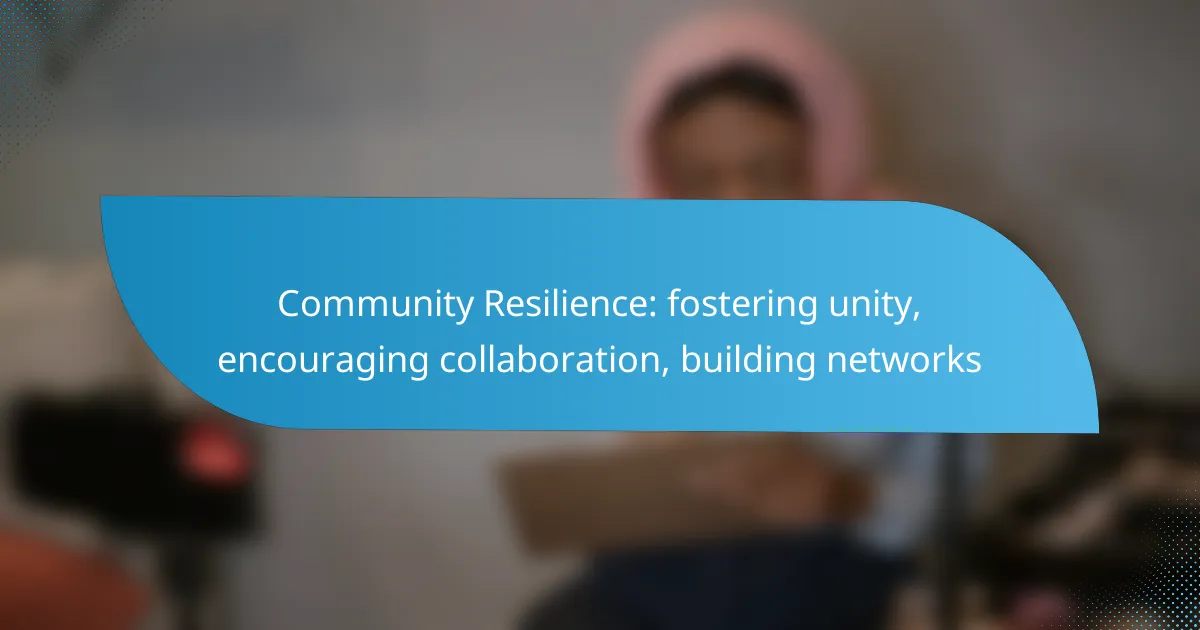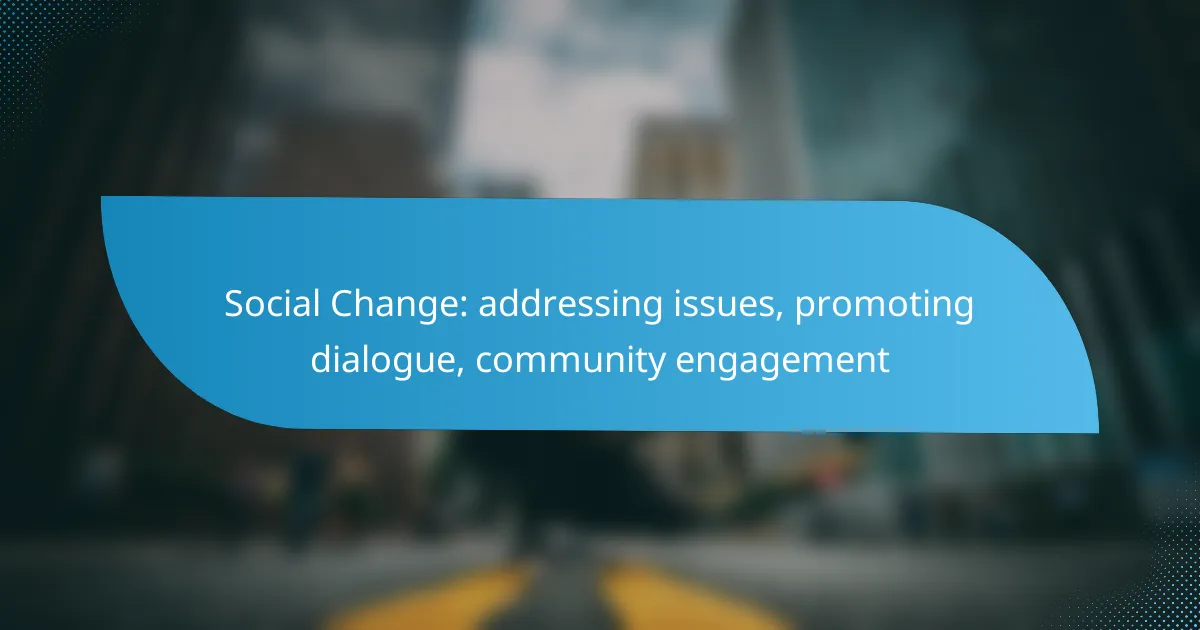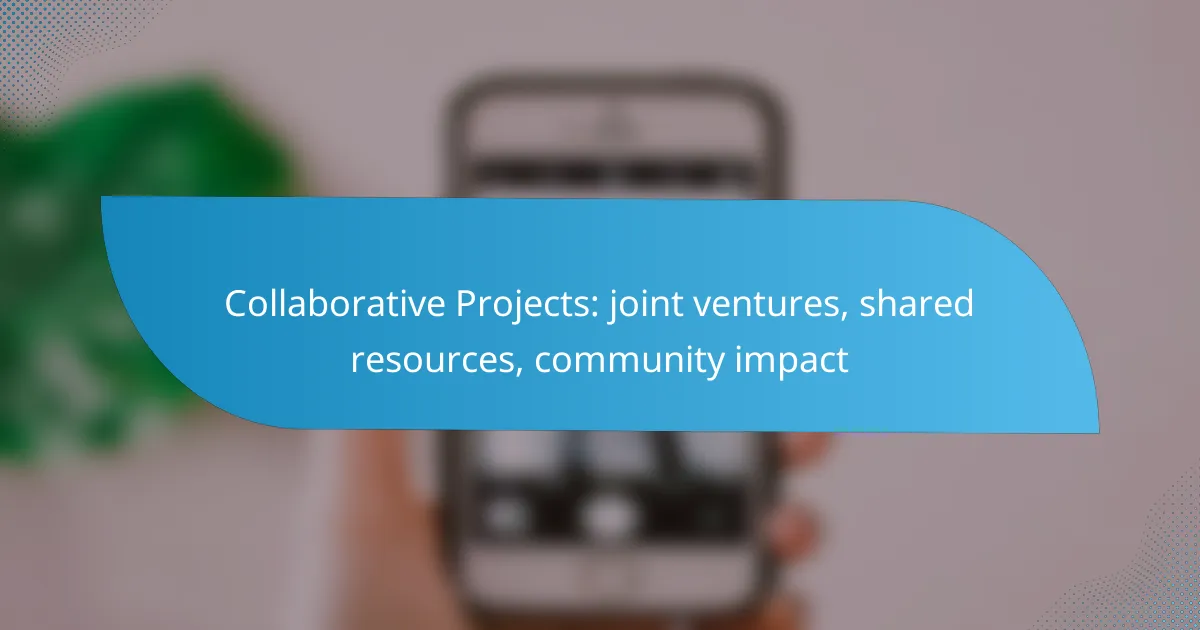Community resilience thrives on unity, collaboration, and the establishment of strong networks among residents and organizations. By actively engaging individuals and fostering open communication, communities can enhance their capacity to respond to challenges and support one another effectively. Building these connections not only strengthens relationships but also facilitates better resource sharing and teamwork, ultimately leading to a more resilient community.
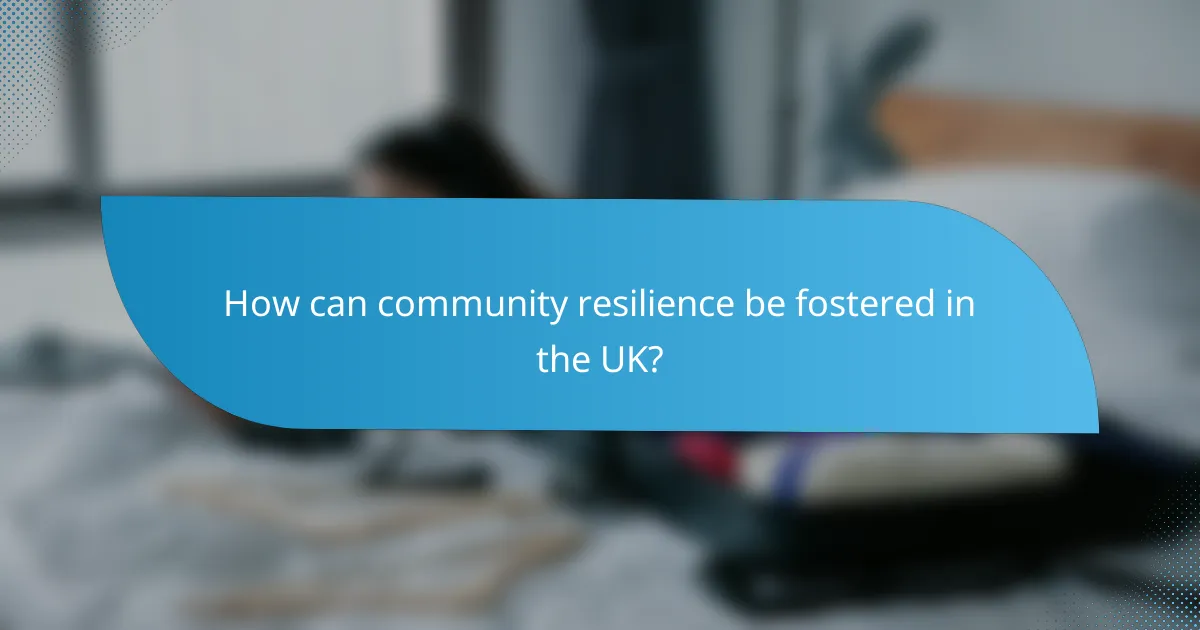
How can community resilience be fostered in the UK?
Community resilience in the UK can be fostered through active participation, collaboration among local entities, and the sharing of resources. By engaging residents and organizations, communities can build strong networks that enhance their ability to respond to challenges and support one another.
Community engagement initiatives
Community engagement initiatives are essential for fostering resilience as they encourage local participation and ownership. Programs such as neighborhood forums, workshops, and volunteer days can help residents connect and collaborate on local issues.
For instance, organizing regular community meetings allows residents to voice concerns and propose solutions, creating a sense of belonging and collective responsibility. Engaging diverse groups, including youth and marginalized populations, ensures that all voices are heard and valued.
Local partnerships and collaborations
Building local partnerships is crucial for enhancing community resilience. Collaborations between local governments, businesses, and non-profits can lead to shared resources and expertise, making it easier to address community needs.
For example, a partnership between a local council and a charity can provide essential services during emergencies, such as food distribution or shelter. Establishing clear communication channels and regular meetings can strengthen these partnerships and ensure effective collaboration.
Resource sharing platforms
Resource sharing platforms facilitate the exchange of tools, knowledge, and support among community members. These platforms can take various forms, including online forums, local co-ops, or community tool libraries.
For instance, a community tool library allows residents to borrow tools for home improvement projects, reducing costs and promoting sustainability. Additionally, online platforms can connect individuals with skills to those in need of assistance, fostering a culture of mutual support and collaboration.
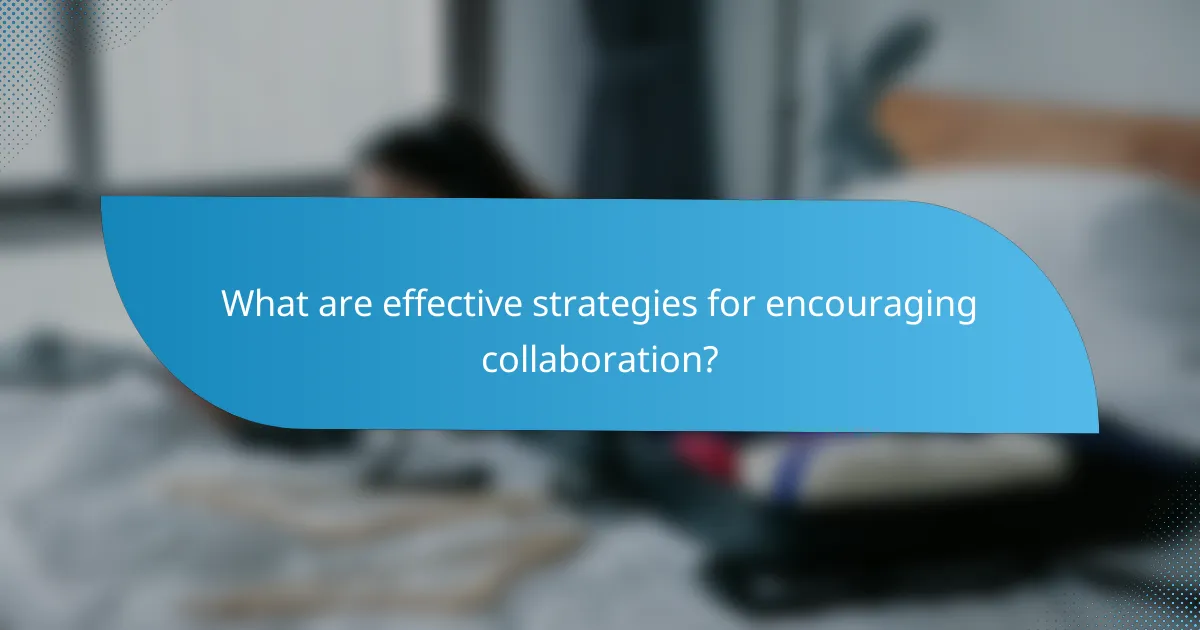
What are effective strategies for encouraging collaboration?
Effective strategies for encouraging collaboration include fostering open communication, providing resources, and creating opportunities for interaction. These approaches help build trust and strengthen relationships among community members, leading to more productive teamwork.
Workshops and training sessions
Workshops and training sessions are excellent ways to enhance collaboration by equipping community members with necessary skills. These sessions can focus on team-building, conflict resolution, or specific project management techniques. Consider hosting regular workshops to keep skills fresh and encourage ongoing engagement.
When planning these events, ensure they are accessible to all community members. Offering sessions at various times and locations can help accommodate different schedules and increase participation.
Online collaboration tools
Online collaboration tools streamline communication and project management, making it easier for community members to work together. Platforms like Slack, Trello, or Asana allow users to share ideas, track progress, and assign tasks efficiently. Choose tools that align with your community’s needs and ensure everyone is trained to use them effectively.
Be mindful of potential challenges, such as information overload or technical difficulties. Establish clear guidelines on how and when to use these tools to maintain focus and productivity.
Community forums and events
Community forums and events provide a platform for members to share ideas, discuss challenges, and celebrate successes. Organizing regular meetups, either in-person or virtually, can foster a sense of belonging and encourage collaboration. Promote these events through local channels to maximize attendance.
Consider creating themed discussions or panels to address specific topics of interest. This targeted approach can lead to deeper conversations and stronger connections among participants, ultimately enhancing collaborative efforts within the community.

How do networks contribute to community resilience?
Networks play a crucial role in enhancing community resilience by fostering connections among individuals and organizations, which leads to better resource sharing and collaboration. These networks enable communities to respond effectively to challenges and adapt to changing circumstances.
Support systems for local businesses
Support systems for local businesses are essential for building resilience within a community. These networks can include local chambers of commerce, business associations, and informal groups that share resources, knowledge, and best practices. By collaborating, businesses can navigate economic challenges more effectively and promote local spending.
For example, a group of local restaurants might collaborate on joint marketing campaigns or share suppliers to reduce costs. This not only strengthens individual businesses but also enhances the overall economic health of the community.
Information exchange networks
Information exchange networks facilitate the flow of critical knowledge and resources among community members. These networks can take the form of online platforms, community forums, or regular meetings where residents share updates, resources, and advice on various topics, such as health, safety, and local events.
Communities can benefit from these networks by staying informed about local issues and opportunities. For instance, during emergencies, timely information can help residents make informed decisions and mobilize resources quickly.
Volunteer networks and community service
Volunteer networks are vital for mobilizing community members to address local needs and challenges. These networks connect individuals with opportunities to serve, whether through organized events or ongoing initiatives. Engaging volunteers fosters a sense of belonging and strengthens social ties within the community.
Communities can organize volunteer days for clean-up efforts, food drives, or support for vulnerable populations. By participating in these activities, residents not only contribute to the community’s well-being but also build relationships that enhance resilience during difficult times.

What role do local governments play in building resilience?
Local governments are crucial in fostering community resilience by implementing policies, providing funding, and facilitating emergency preparedness. Their actions directly influence how communities can collaborate, unite, and respond to challenges effectively.
Policy development and support
Local governments develop and support policies that enhance community resilience by addressing specific needs and vulnerabilities. This may include zoning laws that promote sustainable development or regulations that encourage community engagement in disaster planning.
Effective policies often involve collaboration with local stakeholders, ensuring that the voices of residents are heard. For example, a city might create a community advisory board to guide resilience initiatives, fostering a sense of ownership and participation among citizens.
Funding for community projects
Funding from local governments is essential for implementing community resilience projects. This can include grants for neighborhood improvement initiatives, infrastructure upgrades, or programs that promote social cohesion.
Local governments may allocate budgets specifically for resilience-building activities, often ranging from thousands to millions of dollars depending on the project’s scope. They can also leverage state and federal funds to amplify their efforts, ensuring that resources are available for impactful community projects.
Emergency preparedness programs
Emergency preparedness programs initiated by local governments equip communities with the knowledge and resources needed to respond to disasters. These programs often include training sessions, drills, and the development of emergency response plans tailored to local risks.
By engaging residents through workshops and simulations, local governments can enhance community readiness. For instance, a municipality might organize a yearly disaster preparedness fair, providing residents with essential information and resources to better prepare for emergencies.

How can technology enhance community resilience?
Technology enhances community resilience by facilitating communication, enabling resource management, and fostering outreach. By leveraging digital tools, communities can quickly respond to challenges, share vital information, and strengthen social ties.
Digital communication platforms
Digital communication platforms, such as messaging apps and video conferencing tools, allow community members to stay connected in real-time. These platforms can be used for organizing events, sharing updates, and coordinating responses during emergencies.
Consider using platforms like WhatsApp or Zoom, which are user-friendly and accessible on various devices. Establishing dedicated groups for specific community interests can enhance engagement and collaboration.
Data sharing for resource management
Data sharing tools enable communities to effectively manage resources by providing access to critical information. Platforms that aggregate data on local needs, available services, and volunteer opportunities can streamline support efforts.
For example, using a shared online spreadsheet or a dedicated app can help track food donations, housing resources, or medical supplies. This transparency fosters trust and encourages participation among community members.
Social media for community outreach
Social media serves as a powerful tool for community outreach, allowing organizations to disseminate information quickly and widely. Platforms like Facebook and Twitter can be used to announce events, share success stories, and mobilize volunteers.
To maximize impact, create engaging content that resonates with your audience, such as infographics or videos. Regularly update your community on initiatives and encourage feedback to foster a sense of belonging and involvement.
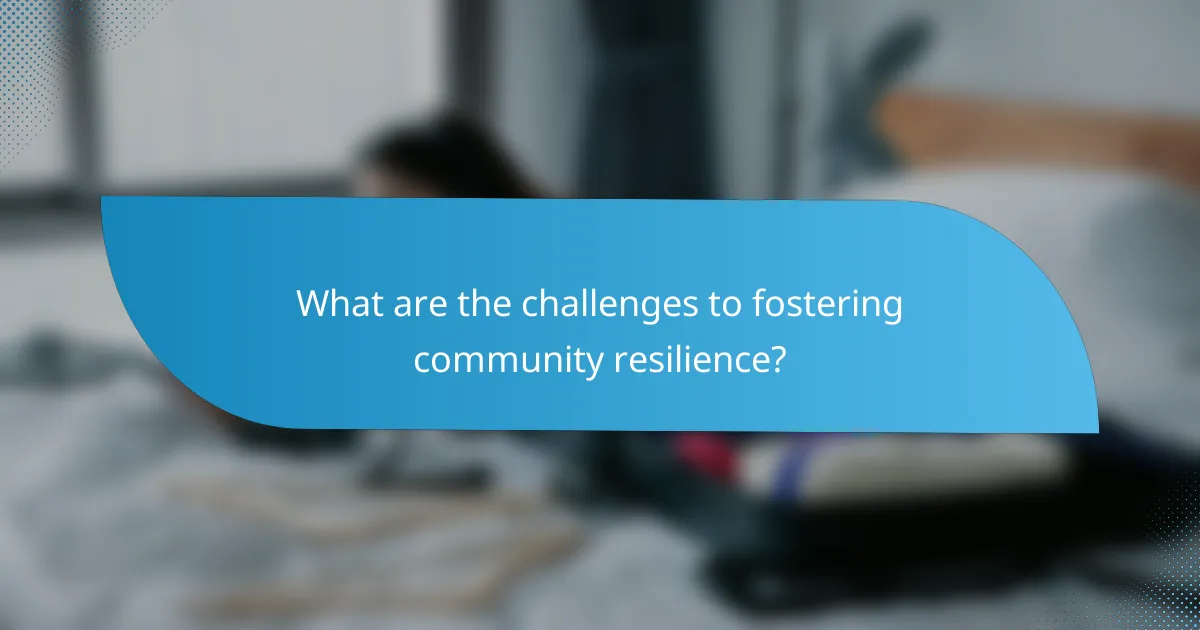
What are the challenges to fostering community resilience?
Fostering community resilience faces several challenges that can hinder effective collaboration and unity. Key obstacles include a lack of funding and resources, which can significantly impact the ability to build strong networks and support systems.
Lack of funding and resources
A primary challenge to fostering community resilience is the lack of adequate funding and resources. Many community initiatives rely on grants, donations, or local government support, which can be inconsistent or insufficient. This financial instability often limits the scope and sustainability of resilience-building efforts.
Communities may struggle to secure funding for essential programs, such as disaster preparedness training or mental health services. Without these resources, it becomes difficult to implement effective strategies that promote collaboration and unity among residents.
To overcome this challenge, communities should explore diverse funding sources, including public-private partnerships, crowdfunding, and local business sponsorships. Establishing a clear budget and demonstrating the potential impact of resilience initiatives can also attract more financial support.






